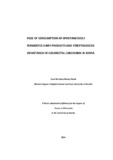| dc.description.abstract | Consumers of traditionally spontaneously fermented dairy products are
frequently exposed to high titres of Streptococcus infantarius subsp.
infantarius (Sii), that belongs to Streptococcus bovis/Streptococcus equinus
complex (SBSEC) - potential pathogens implicated in colonic and non-colonic
carcinoma and extraintestinal infections.
Study objectives were to determine the association between consumption of
fermented dairy products, selected six environmental risk factors of CRC and
isolated human faecal strains of Sii/SBSEC with colorectal cancer; and to
estimate the safety and pathogenicity associated with the strains obtained in
this PhD study by comparing their gene sequence types with a global pool of
Sii/SBSEC strains.
A case-control study was conducted from June 2013 to June 2015 at the
Endoscopy Unit of Kenyatta National Hospital, Nairobi (Kenya). Study
participants were 413 adults waiting for colonoscopic examination who gave
written consent after they were informed about the study.
Overall, 92 out of 413 (22%) participants consumed fermented dairy products
(FDP); 20.6% and 24.2% in urban and rural areas, respectively. Faecal carriage
of Sii was higher in rural areas than urban areas (16.5% vs 13.0%, p-value (p)
0.46). Prevalence of colorectal adenocarcinoma was higher among persons
originating from rural areas (16% vs 23%; p 0.05). Consumption of FDP was
not associated with CRC (odds ratio (OR) 1.4; 95% Confidence interval (CI) 0.7-
2.7; P=0.34). Age being above 40 years and consumption of processed meat
and alcohol emerged as risk factors of CRC. Although persons with colon
tumors and polyps (16.7%: n: 36; CI 6.4%-32.8%) compared to controls
(10.6%, n: 94; CI: 5.2%-18.7%), had higher faecal carriage of Sii, the difference
was not statistically significant.
MLST characterization confirmed the identity of 40 SBSEC which comprised 33
Sii, five Streptococcus lutetiensis, four Streptococcus gallolyticus subsp.
pasteurianus, and one Streptococcus gallolyticus subsp. macedonicus
previously identified with groEL gene sequence. One out of 33 Sii was
confirmed to harbour lacS and lacZ while none of the other SBSEC isolates
were detected positive for this dairy adaptation. One out of 33 Sii clustered
with the pathogenic strains sourced from Spain. Sgp and S. lutetiensis have
unique thrS alleles and Sii D1266 has a regular thrS allele which groups that
isolate with blood isolates. The remaining Sii clustered with dairy isolates and
have resemblance to Streptococcus thermophilus.
In conclusion, Consumption of FDP is not associated with CRC but elevates
faecal carriage of Sii/SBSEC. Sii-D1266 isolate is a health hazard and the
remaining 32 Sii isolates are potentially harmless to humans. Further
elucidation of safety of Sii isolates are proposed to determine their potential
role as candidates for development of a novel starter culture for fermented milk products. | en_US |



